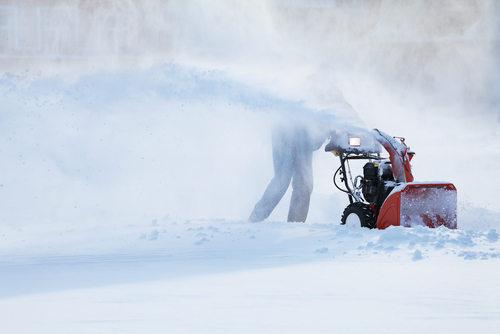Now that we are halfway through winter, facilities professionals doing their own snow removal in areas of the country that have seen a lot of the white stuff might realize they don’t have the proper equipment.

It’s important for large facilities like colleges, hospitals, and malls that have big areas comprising parking lots, roads, and sidewalks to have the right tools for snow removal. Facilities in states that tend to have the most snow, like Vermont, Colorado, Alaska, and Michigan, should be more prepared for heavier snowfalls.
Facilities managers who want to learn how specific chemicals can help with reducing winter weather hazards, as well as those who want to hire commercial snow service companies, should read “Getting Your Facility Ready for Snow and Ice” on Facilities Management Advisor.
Why?
Untreated snow and ice could deter customers from coming to a facility and could prevent employees from accessing their worksites. Neglecting to promptly take care of these conditions could also cause a loss of profits, a lack of staff, injuries, and lawsuits by those injured.
Additionally, states and cities have different ordinances regarding snow and ice removal for sidewalks, curb ramps, and crosswalks, which could result in hefty fines if not adhered to. To learn more, check out the Federal Highway Administration’s (FHWA) “Guide for Maintaining Pedestrian Facilities for Enhanced Safety Research Report.”
Shovels
Shovels are the most basic piece of snow removal equipment for sidewalks and steps and are ideal for removing snow in areas trucks can’t reach. Use reflective tape on the shovel’s base to increase visibility.
The Occupational Safety and Health Administration (OSHA) recommends that shovelers scoop small amounts of snow and push the snow rather than lift it, as well as keep their backs straight, lift with their legs, and not turn or twist their bodies.
Some Factors in Choosing a Snow Shovel
Type of snow: Use shovels with longer blades for wet and heavy snow and shovels with shorter blades for light and fluffy snow.
Amount of snow: Use push shovels for small snowfalls, but consider other options like traditional or combo shovels (with a scoop design good for lifting and pushing snow) for heavy snowfalls.
Strain: To reduce back strain, consider electric shovels, which can be corded or battery-powered, for sidewalks. However, for heavy snow, consider ergonomic snow shovels, which eliminate the need to bend too far.
Damage: Shovels with metal blades are more likely to scratch pavement or stairs than plastic blades.
Price: You can best remove compact snow and ice with shovels that have metal blades, but they cost more than aluminum and plastic shovels.
Snow Rakes
Snow rakes, which resemble a garden hoe with a long handle, are necessary to prevent roofs from collapsing due to heavy snow.
However, you should exercise caution when climbing on roofs to remove snow and ice; first determine whether the roof can support the load weight of a worker and the snow.
OSHA has investigated incidents when facilities professionals have been injured or killed while removing snow, so the agency recommends removing snow from the ground or using an aerial lift.
There are two primary types of snow rakes:
- Slicers cut snow like a cheese slicer and push the snow up using wheels.
- Scoops are shaped like a snow shovel and push snow down into gutters or onto shrubs.
Snow Throwers vs. Snowblowers
Two additional options facilities professionals have for removing snow are snow throwers, which are great for light and fluffy snow on sidewalks and small areas, and snowblowers, which are the best option for heavy and wet snow in parking lots.
Snow throwers are a good choice for places with mild winters and smaller properties, but snowblowers work better in harsh winter conditions and for larger properties.
But despite snowblowers’ usefulness, hundreds of thousands of people experience serious damage to their fingers or hands because they handled them improperly. The American Society for Surgery of the Hand reminds people to turn off their snowblower if it clogs and disengage the clutch before using a stick or broom handle to clear impacted snow.
Plows
When attaching a plow to a vehicle, consider the vehicle’s physical size, horsepower, and type. Failing to do so could damage the vehicle, the plow, or both.
Also, based on the needs of your facilities’ parking lots, choose the appropriate type of snowplow:
- Straight plows are great for clearing snow from large, open spaces during small snow events.
- V-plows are the ideal option for dense and high snow and have the ability to push snow on either side.
- Box plows are often attached to tractors and are used for complete snow removal.
Gritters
Found on most winter service vehicles, gritters spread grit (usually rock salt) onto roadways and are typically attached to a truck. Grit helps prevent the formation of ice and wears down existing snow and ice and is more effective in high-traffic areas. The best time to use grit is when the ground is damp but not frozen. While brown grit is usually used, it is best to use clear grit in front of businesses.
Loaders
Several types of snow removal loader solutions facilities managers should consider include the following:
- All-wheel loaders are open-cab or enclosed vehicles that clear heavy snow in tight areas, as well as have great traction on icy surfaces.
- Excavator loaders are enclosed vehicles that dig and plow heavy and fluffy snow.
- Front-end loaders are enclosed vehicles designed to handle several feet of snow but are too large to enter tight areas.
- Walk-behind loaders are small vehicles that operators walk behind to remove snow from sidewalks.
Taking all the above into consideration, facilities professionals should determine what snow removal options would work best for their properties and location.
